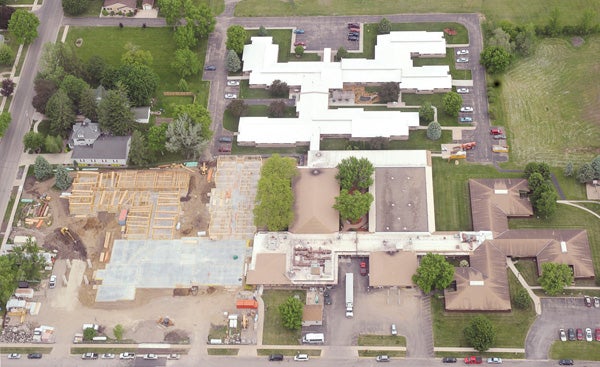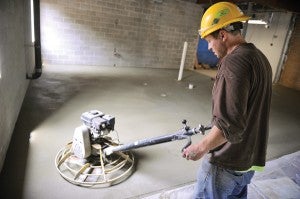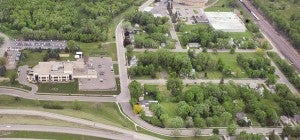Expanding horizons
Published 10:00 am Monday, June 4, 2012

St. Marks is one of several businesses in Austin that are either in the process of expanding or plan to expand. - Eric Johnson/photodesk@austindailyherald.com
A boom in building is demonstrating Austin’s growth
Big developments carry a big price tag, and Austin’s upcoming development projects for 2012 are no exception.
This year’s potential projects weigh in at an estimated $72 million valuation, well above the mark for each of the past three years. Craig Hoium, the city’s community development director, said that’s an auspicious sign for Austin.

Isaiah Wagner of Wagner Construction, uses a trolly machine to smooth concrete Thursday afternoon in the Woodson Kindergarten expansion. - Eric Johnson/photodesk@austindailyherald.com
“I think personally that the economy is rebounding slowly,” Hoium said. “But to have all these positive developments occur in the community at this time is just a real positive thing.”
Last year, the city had $53 million on construction projects, Hoium said. That was more than twice the $22 million seen in 2010, and included an addition and campus upgrades to Mayo Clinic Health System in Austin, school improvements and a new Anderson Construction office building. The medical center’s expansion alone will add about 70 jobs when it’s finished in early 2013.
Residential development over the past four or five years has been down — Austin added eight new homes in 2011 compared to 11 in 2010 and 13 in 2009 — but the jobs these large projects will create are likely to spur it to life again, he said.
“That should stimulate the residential development,” Hoium said.
Overall, Hoium said, Austin is showing positive signs.
“Austin’s been quite fortunate with the past recession,” he said. The city’s unemployment rate has been one of the lowest in Minnesota outside of the larger metropolitan areas — at 4.6 percent in April compared to 5.2 percent statewide, according to the Minnesota Department of Employment and Economic Development — and the local option sales tax data shows Austin has seen an increase in retail sales over the past two years, with total retail sales at about $296 million in both 2011 and 2010, compared to $280 million in 2009 and $245 million in 2008.
Also, three of the last four months show in improvement from that month the year before.
“We’ve been really fortunate over the past few years with a lot of commercial-type developments and developments that either have or are going to be creating new full-time positions,” Hoium said. The $27-million Hormel Institute expansion on its own is forecast to create 125 jobs.
The number of permits issued and the construction valuation, Hoium said, can illustrate how the city is doing.
“If you consider having a successful year or not, those are two key factors,” he said. “If you look at a comparison to other communities, there are a lot of communities that didn’t break $20 million.
Compared to Austin’s $53 million, Albert Lea spent just $10 million in 2011 and Faribault spent $31 million. Owatonna exceeded Austin’s construction value with $55 million. But in 2012, Hoium projects a conservative estimate for the total valuation for all building permits to be between $60 and $70 million without The Hormel Institute expansion, which could be pushed back to 2013. Add that project in 2012, and it would be between $90 and $100 million.

The Hormel Institute will soon be expanding to the east where land as been purchased and houses torn down in preparation. - Eric Johnson/photodesk@austindailyherald.com
Austin’s hiked focus on projects is a relevant development. The combined valuations over the last three years shows Austin, Faribault, Owatonna and Winona have been fairly even, with Austin coming out on top at $123 million, compared to $113 million for Owatonna, $111 million for Winona and $100 million for Faribault. But by the end of 2012, Austin could have a substantial lead.
A rapid pace
The increase in area construction isn’t just random happenstance. Whether it’s taking advantage of low loan interest rates to finance buildings, or the growing demand from an increasing population, businesses and organizations are growing at a frantic pace in Austin.
The city’s population grew from 23,314 residents in 2000 to 24,718 residents in 2010, according to U.S. census data. While the housing market has yet to recover from the 2008 sub-prime mortgage crash, Austin and Minnesota’s manufacturing business conditions have improved considerably since crashing in 2009, according to Federal Reserve Bank of Minneapolis survey reports. Hormel Foods Corp. has gone through a record amount of growth over the past several years, reporting substantial growth in annual profit the past four years; from $286 million in 2008 to $342 million in 2009, then $396 million in 2010 and $474 million in 2011.
Manufacturing orders in the Midwest were up in 2011 for 53 percent of survey respondents, according to a December 2011 Federal Reserve report. Austin is one of several greater Minnesota cities with strong food manufacturing jobs which attract more people and thus attract more need for businesses and schools, hence the boom. What’s more, Mower County attracted more young people between 2000 and 2010, which is to be expected with counties that have food processing plants, according to state officials.
As food processing companies increased in size over the past 20 years, so too has the demand for plant workers.
“Where do you find people willing to work? Young people,” State Demographer Tom Gillaspy said last year.
That uptick in manufacturing, combined with more people and a need for business expansion means Austin could be in a position to grow even further.
“It also creates a positive feeling about the community,” said Curt Larson, president of the Economic Development Association of Minnesota.
Larson is the Economic Development Specialist for the city of Blaine, which is going through its own economic boom. He said the increase in expansion work and jobs to the community creates a positive effect in attracting more people and thus more businesses with more construction work.
“It’s amazing to follow what impact an employer does for an expansion,” Larson said.
Not only that, the slowly but steadily gaining economy created opportunities for contractors and commercial entities alike. Low interest rates and lower than average construction costs helped get many projects off the ground.
Austin Public Schools in particular has benefitted from interest rates and low costs. The district sought a $29 million referendum last fall to build a new middle school and Woodson Kindergarten Center expansion using interest rates at around 3.7 percent. When district officials approved the sale for $29.3 million in bonds in January, they secured a 2.97 percent interest rate, which meant taxpayers will pay $2.15 million less on the projects over the next 20 years.
“I don’t think we could have picked a better time,” said finance and operations director Mark Stotts.
Stotts said construction costs helped project bids come under budget as well. The Woodson expansion, site work for the new school and work on new tennis courts west of Neveln Elementary School were all bid under district projections. Stotts hopes the trend will continue when the district bids out the new school construction project next week.
A helping hand
The uptick in major construction projects has an obvious impact on construction-related businesses, and Austin is reaping the rewards in that arena, too.
For the expansion at Mayo Clinic Health System in Austin, there has been an average of 70 construction workers on site since the project began in fall 2011, according to Rod Nordeng, the medical center’s vice president of operations and human resources. Nordeng points out that other local businesses benefit from the added labor, as half of them live in the county, and many others eat or get gas in Austin.
A project that size, at $28-million, also has a big impact on construction-related companies. Nordeng said the medical center has contracted with numerous companies in Austin, including Damel Corporation, Southern Minnesota Masonry of Austin, Wagner Construction, Pro-Line Distributing, ProBuild, Austin Ready Mix Concrete, Rent N Save, Veit Disposal, Christian Brothers Sealcoating, and even Nicol’s Fast Lube & Car Wash for diesel fuel.
The Mower County Jail and Justice Center project, which cost $28 million and was completed in the fall of 2010, included $1.6 million for duct work, $1 million for heating and air conditioning, $800,000 for plumbing and a $279,000 sprinkler system, according to Hoium.
“There’s just a large number of jobs connected to those expansions,” said Sandy Forstner, executive director of the Austin Area Chamber of Commerce.
But residential construction is still lagging, something Carter Wagner, president of The Joseph Company, an Austin-based general contractor, points out.
“So there’s still a lot of workers in the construction trade who are looking for a project,” he said.
The Joseph Company is remodeling a few businesses on Main Street, and it just finished a renovation of a 25,000-square foot facility on 14th Street Southeast, which will house four businesses, including two startups: golf shoe wholesaler GoBe Golf and lighted screen printing producer Ellumilite. While the large projects continue, local construction companies will watch for signs the good news is pouring into the housing market.





